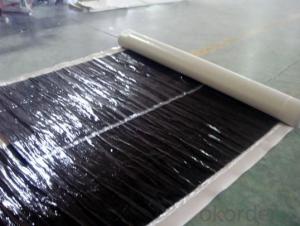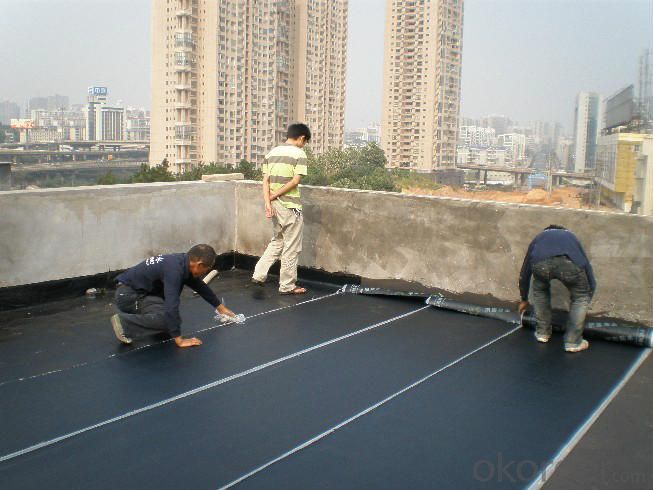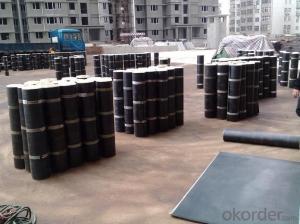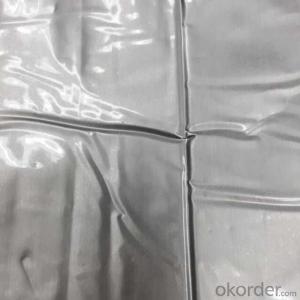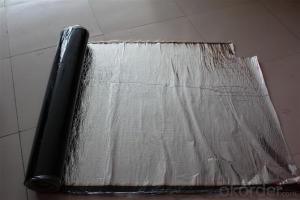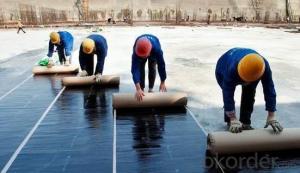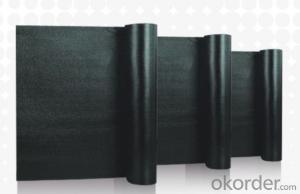Self Adhesive Polymer Modified Bitumen Waterproof Membrane
- Loading Port:
- China main port
- Payment Terms:
- TT OR LC
- Min Order Qty:
- 5000 m²
- Supply Capability:
- 100000 m²/month
OKorder Service Pledge
OKorder Financial Service
You Might Also Like
Introduction
Wide self-adhesive pre PU polyester tyre water-proof coiled material (hereinafter referred to as pre Pu py) is to pitch based polyester tyre water-proof coiled material as the main material (add functional additives), both sides are coated with a self-adhesive layer and attached strippable coating silicon film as insulating material made of self-adhesive water-proof coiled material.
Wide self-adhesive macromolecular pre Pu waterproofing materials (hereinafter referred to as pre shop class P) with ethylene vinyl acetate (EVA), high density polyethylene (HDPE) homogeneous sheet material as the main body, covered with the self-adhesive layer, then covered with a silicon coated isolation membrane made of high polymer self-adhesive waterproofing membrane. According to the engineering needs, it can be in the polymer layer on the composite soil fabric, strengthen the strength of the membrane.
Wide wet PU polyester tyre water-proof coiled material is to pitch based polyester tyre water-proof coiled material as the main material (add functional additives), single or double coated adhesive layer and attached peelable coated silicon membrane as barrier materials made of wet laid waterproofing membrane.
Specification
Thickness | 3mm, 4mm, 5mm |
Width | 1m |
length | 7.5m, 10m, 15m, or on demand |
Base | Polyester or Fiberglass felt |
Surface | PE film, Aluminum foil, Yellow sand, Shale gravel(Schist), colored sand |
Type | could self-adhesive |
Notice | SBS modified bitumen membrane is specially applied in the cold district, APP modified bitumen membrane is more suitable for hot district with high temperature. could be self-adhesive modified bitumen membrane |
Advantages
Excellent waterproofness;
Unique creep properties and self-healing capability which can recover by itself;
Strong adhesion which can targeted the leakage in localized areas;
Tight joints, good extensibility;
Good stability and corrosion resistance, lasting effect.
FAQ
1. Is sample available before place orders?
A: Yes, sample is ok.
2. How long is the dispatch period?
A: It will be around 20-30 days.
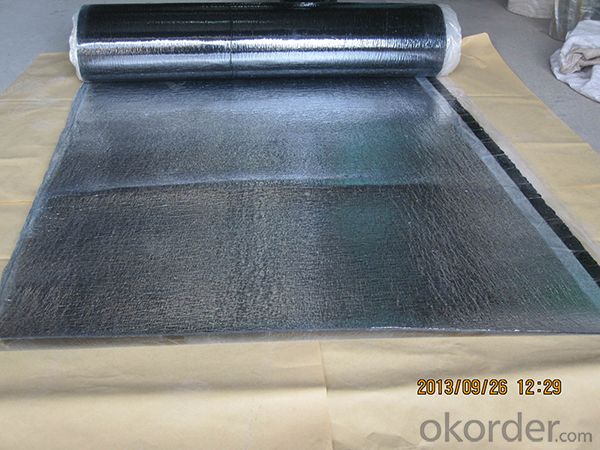
- Q: Can a waterproofing membrane be used in areas with high levels of salt or saltwater exposure?
- Yes, a waterproofing membrane can be used in areas with high levels of salt or saltwater exposure. However, it is important to choose a membrane specifically designed to withstand such conditions. Certain waterproofing membranes are specifically formulated to be resistant to salt and saltwater exposure, preventing any potential damage or degradation. These membranes are typically made with materials that are highly resistant to corrosion and have enhanced durability. It is crucial to consult with a professional to ensure the correct type of waterproofing membrane is selected for high salt or saltwater exposure areas to ensure long-term effectiveness and protection.
- Q: Can a waterproofing membrane be used on steel surfaces?
- Indeed, steel surfaces can benefit from the application of a waterproofing membrane. These membranes are specifically designed to establish a shield against moisture and water incursion, and they possess the versatility to be utilized on a range of surfaces, including steel. Construction endeavors, including roofs, balconies, and foundations, frequently feature steel surfaces. By employing a waterproofing membrane on these steel surfaces, one can effectively thwart corrosion and harm arising from water contact. It is crucial to carefully choose a waterproofing membrane that suits steel surfaces, while also adhering to correct surface preparation and application techniques to attain maximum performance and longevity.
- Q: Can a waterproofing membrane be used for a residential building?
- Yes, a waterproofing membrane can be used for a residential building. A waterproofing membrane is a thin layer of material that is applied to the exterior walls, foundation, or roof of a building to prevent water from penetrating into the structure. It acts as a barrier against moisture, preventing water damage and mold growth, and can also help to improve the energy efficiency of the building by reducing heat loss. In a residential building, a waterproofing membrane can be used in various areas such as basements, bathrooms, balconies, roofs, and exterior walls. It is particularly useful in areas that are prone to water infiltration, such as basements where groundwater can seep in, or bathrooms where water splashes and steam can cause moisture issues. There are different types of waterproofing membranes available, including liquid-applied membranes, sheet membranes, and self-adhering membranes. These membranes are designed to be durable, flexible, and resistant to water, ensuring long-lasting protection for the residential building. By using a waterproofing membrane, homeowners can safeguard their property from water damage, structural issues, and health hazards associated with moisture intrusion. It is important to consult with professionals to determine the specific type of waterproofing membrane that is suitable for the residential building based on the location, climate, and potential sources of water infiltration.
- Q: Can a waterproofing membrane be used for seawalls or bulkheads?
- Seawalls or bulkheads can benefit from the use of a waterproofing membrane. These membranes are specifically designed to create a barrier against water, and they can be applied to various structures, including seawalls and bulkheads. The materials used for these membranes, such as bitumen, rubber, PVC, or polyurethane, are known for their excellent resistance to water and their ability to maintain the integrity of the wall or bulkhead. By applying the membrane to the surface of the structure, a continuous and durable waterproof layer is formed, effectively preventing water from seeping through. This protective layer helps safeguard the seawall or bulkhead from erosion, corrosion, and other types of damage caused by exposure to seawater. Moreover, waterproofing membranes offer additional advantages, including increased durability, improved aesthetics, and enhanced resistance to UV rays and chemicals. In conclusion, the use of a waterproofing membrane is a reliable solution for ensuring the long-term performance and durability of seawalls and bulkheads in marine environments.
- Q: Can a waterproofing membrane be used for podium decks or plaza areas?
- Podium decks or plaza areas can benefit from the application of a waterproofing membrane. It is highly recommended to utilize this protective layer in order to safeguard the underlying structure from water-related harm. Given their exposure to the elements, podium decks and plaza areas are susceptible to water infiltration. By implementing a waterproofing membrane, water seepage into the lower layers can be effectively prevented, thus ensuring the long-lasting durability and structural integrity of the deck or plaza. Furthermore, this waterproofing membrane is also capable of shielding spaces beneath the deck or plaza, such as basements or parking garages, from potential water damage. Therefore, it is crucial to select a top-notch waterproofing membrane specifically designed for outdoor purposes, and to carefully adhere to the manufacturer's instructions regarding proper installation and maintenance.
- Q: What is the material on the insulation layer on the waterproofing membrane?
- 2, waterproof layer on the other construction layer construction, it is possible to pierce the waterproof layer, the appropriate protection Is necessary, the isolation layer can also play a protective role.
- Q: Can a waterproofing membrane be used in swimming pools or water features?
- Swimming pools or water features can benefit from the use of a waterproofing membrane. This type of membrane is commonly employed in these scenarios to establish a barrier between the water and the surrounding structure. By doing so, it prevents any water leakage and structural damage, ultimately ensuring the swimming pool or water feature's longevity and durability. Typically, the membrane is applied to the structure's surface and can be composed of various materials like rubber, PVC, or bitumen. It is imperative to select a membrane specifically designed for underwater applications to guarantee its effectiveness in providing a watertight seal. Furthermore, proper installation and regular maintenance of the waterproofing membrane are vital to uphold its long-term performance.
- Q: Can a waterproofing membrane be used for soundproofing purposes?
- To some extent, a waterproofing membrane can serve the purpose of soundproofing as well. While its primary function is to prevent water from seeping through, it also has the ability to minimize sound transmission. Typically, waterproofing membranes are constructed using materials that possess excellent acoustic properties, such as rubber or a combination of rubber and asphalt. These materials have the capability to absorb and muffle sound waves, resulting in a reduction in noise that can penetrate walls or floors. However, it's important to note that the soundproofing capabilities of a waterproofing membrane may not be as substantial as those of specialized soundproofing materials like acoustic panels or insulation. Therefore, if soundproofing is the main objective, it is advisable to consider utilizing dedicated soundproofing solutions in conjunction with or instead of a waterproofing membrane.
- Q: How to use self-adhesive waterproofing membrane?
- Second, the cement mortar paste self - adhesive waterproofing membrane (mainly applicable to the basement is not leveling the basement roof, roof and other waterproofing works. 1. Cement mortar with the wiping paste self-adhesive waterproofing membrane Construction process: grass-roots treatment - → wiping cement (waterproof) mortar - → peel off the self-adhesive waterproof membrane under the surface of the isolation film - → shop self-adhesive waterproofing membrane - → tapping the surface of the membrane, mention pulp - → (24 hours to 48 hours) - → on the interface seal - → node reinforcement - → quality acceptance
- Q: Can a waterproofing membrane be used for a water tank?
- Yes, a waterproofing membrane can be used for a water tank. A waterproofing membrane is designed to prevent the passage of water, making it an ideal solution for sealing and protecting water tanks. It can effectively prevent leaks and seepage, ensuring that the water stored in the tank remains intact without any loss or contamination. Additionally, a waterproofing membrane can also provide added durability and longevity to the tank by protecting it from external factors such as corrosion, chemicals, and UV radiation. It is important to choose a high-quality waterproofing membrane that is specifically designed for water tanks to ensure optimal performance and long-lasting protection.
Send your message to us
Self Adhesive Polymer Modified Bitumen Waterproof Membrane
- Loading Port:
- China main port
- Payment Terms:
- TT OR LC
- Min Order Qty:
- 5000 m²
- Supply Capability:
- 100000 m²/month
OKorder Service Pledge
OKorder Financial Service
Similar products
Hot products
Hot Searches
Related keywords
